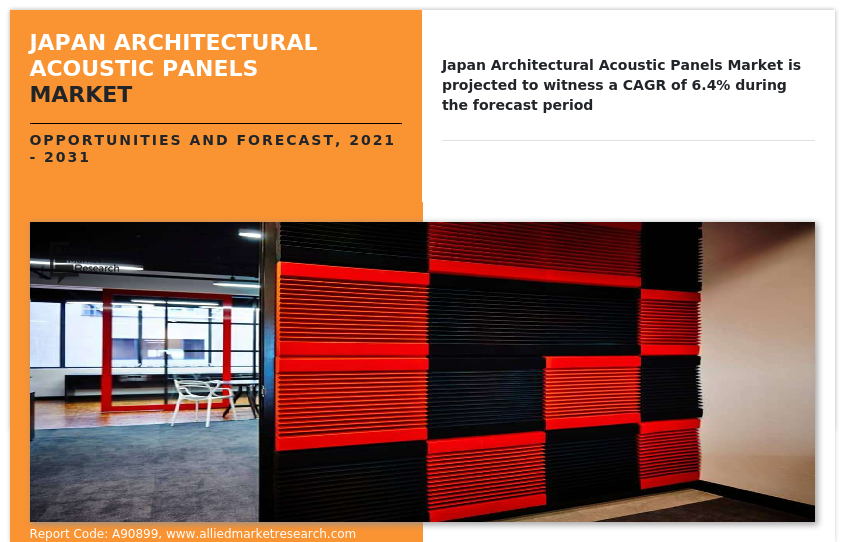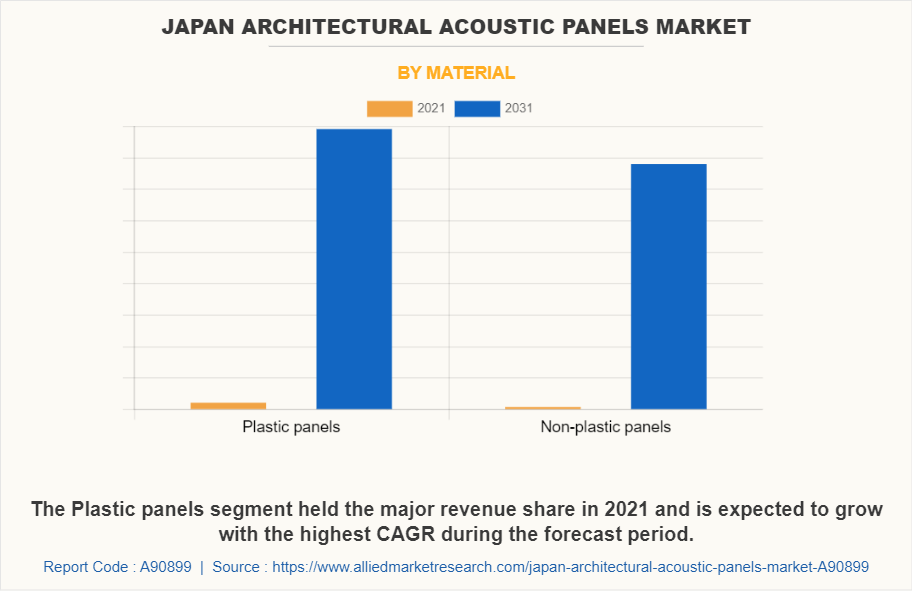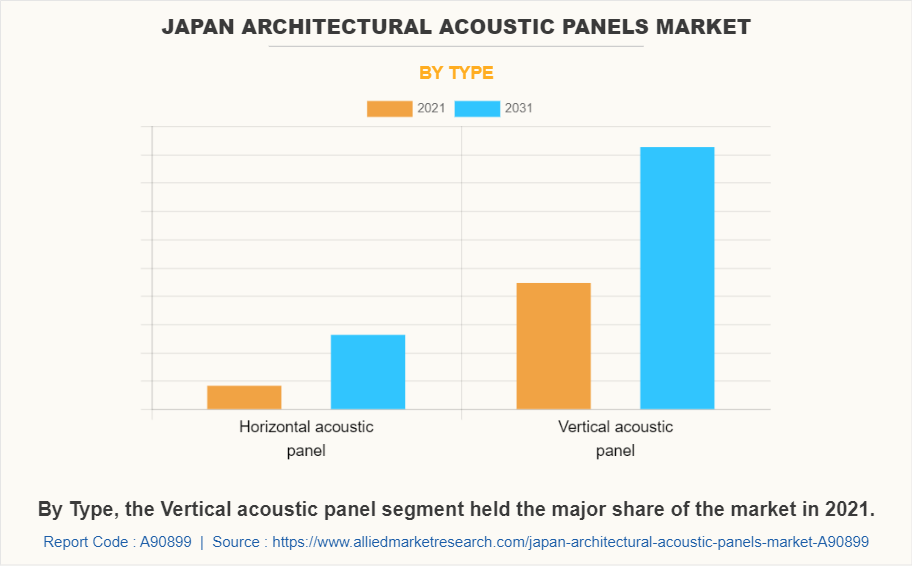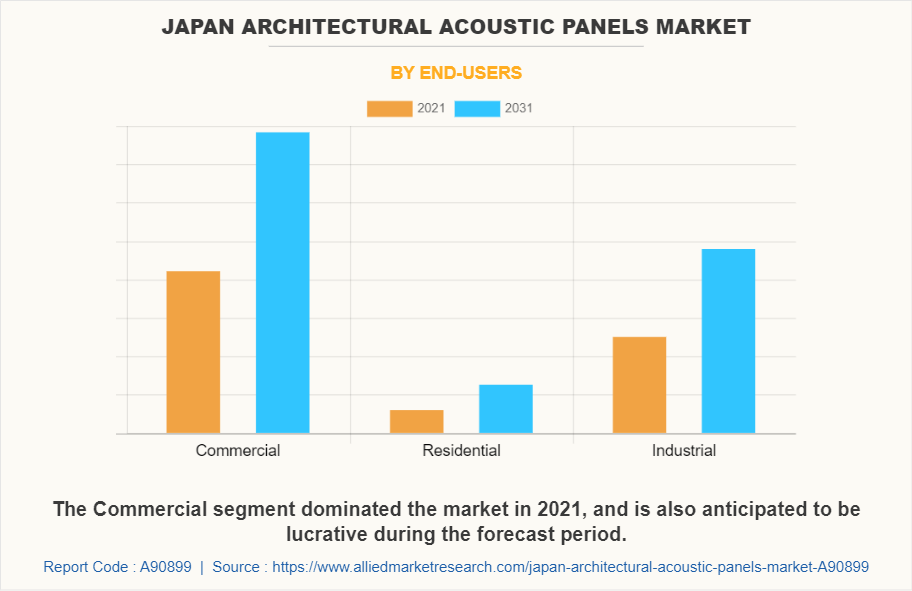The Japan architectural acoustic panels market has witnessed substantial growth during the projection period. The growth of the market is driven by several factors. Primarily, there is rise in emphasis on aesthetics and acoustics in architectural designs, which has created a demand for these panels. In today's era, spaces need to be both visually appealing and acoustically optimized, and these panels serve this dual purpose. Moreover, there is rise in awareness about the negative effects of noise pollution, which has made acoustic solutions more important. With the rise of urbanization, noise pollution has become a persistent problem. Architectural acoustic panels provide an effective solution for reducing noise and improving the quality of life.

Furthermore, advancements in material technologies have expanded the options available to consumers. Plastic panels and non-plastic panels each have their own unique characteristics, allowing consumers to choose based on their specific requirements. This variety of materials is a key driver behind the market's growth. In addition, government initiatives and regulations promoting sustainable construction practices have played a significant role in boosting the market. The focus on eco-friendly materials and designs has led to the adoption of acoustic panels that are functional and environmentally responsible.
On the other hand, the Japan architectural acoustic panels market encounters certain obstacles. One significant challenge is high expense associated with high-quality acoustic panels. The utilization of high-quality materials and advanced manufacturing techniques significantly increases the cost of these panels, rendering them less accessible to certain market segments. Furthermore, installation of acoustic panels demands technical expertise, which acts as a deterrent for some customers. Consequently, this hinders the market's expansion and limits its potential for growth. Moreover, the market faces competition from alternative solutions such as soundproofing materials and architectural modifications. The decision-making process for consumers becomes perplexing when choosing between these alternatives, underscoring the importance for acoustic panel manufacturers to effectively differentiate their products.

However, the Japan architectural acoustic panels market is set to undergo further development, with numerous prospects on the horizon. It is imperative to take into account the subsequent trends and opportunities that are expected to shape the market's landscape. One noteworthy trend is incorporation of intelligent and interconnected acoustic panels. With the emergence of the internet of things (IoT), these panels are equipped with sensors to monitor and adjust to acoustic conditions in real-time. This presents a level of personalization and adaptability that was previously inconceivable. Furthermore, the market is experiencing a shift toward more environmentally sustainable materials. The demand for panels crafted from recycled or renewable materials is increasing, aligning with global sustainability objectives.

The Japan architectural acoustic panels market is segmented into material, type, and end user. Depending on material, the market is bifurcated into plastic panels and non-plastic panels. By type, it is classified into horizontal acoustic panel and vertical acoustic panel. On the basis of end user, the market is segregated into commercial, residential, and industrial.
The market is projected to experience significant growth primarily driven by the commercial sector. This sector, encompassing offices, hotels, and restaurants, is witnessing rise in demand for acoustic solutions to enhance the ambiance and productivity of their spaces. Consequently, the demand for acoustic panels in this sector is substantial.
Moreover, the residential segment plays a crucial role in the market for acoustic panels. Homeowners are increasingly seeking ways to improve the acoustics of their living spaces, leading to a notable demand for acoustic panels in this segment. Furthermore, the industrial applications of acoustic panels, such as in factories and manufacturing units, contribute to the market's growth. These panels are utilized for noise control and safety measures, indicating potential growth opportunities in this segment as well.

Innovation in product development serves as a catalyst for the market's progression. Manufacturers continuously strive to create acoustic panels that deliver exceptional acoustic performance and align with the latest design trends. New products incorporate cutting-edge materials, enhanced acoustic properties, and improved installation methods. Moreover, R&D efforts play a crucial role in driving advancements in acoustic technology, contributing to the development of environmentally friendly materials, improved acoustic performance, and cost-effective solutions. The ongoing R&D efforts heavily influence the evolution of acoustic panels.
For manufacturers in this market, understanding consumer and end-user perceptions is of utmost importance. Consumers are increasingly aware of the impact of acoustics on their living and working environments. Therefore, companies tailor their products and marketing strategies to address consumer preferences and concerns. Pricing holds significant importance in the Japan architectural acoustic panels market. Manufacturers strike a balance between offering high-quality products and competitive pricing. Pricing strategies take into account the cost of materials, production, and installation, and the perceived value of the product in the market.
A SWOT analysis analyzes the internal strengths and weaknesses and the external opportunities and threats. The strengths of the Japan architectural acoustic panels market are diverse product offerings, increase in emphasis on aesthetics and acoustics in architecture, rise in the awareness of noise pollution issues, and advancements in material technologies. Weaknesses include high cost associated with high-quality panels, technical expertise required for installation, competition from alternative solutions, and change in consumer perceptions and preferences.
Opportunities for the market include integration of smart and connected panels, demand for sustainable and eco-friendly materials, regulatory landscape, and growth in the commercial & residential sectors. Threats to the market include competition from alternative soundproofing solutions, economic factors affecting industrial sector growth, supplier power variations based on materials, and intense competitive rivalry in the market.
Key Benefits For Stakeholders
- Enable informed decision-making process and offer market analysis based on current market situation and estimated future trends.
- Analyze the key strategies adopted by major market players in Japan architectural acoustic panels market.
- Assess and rank the top factors that are expected to affect the growth of Japan architectural acoustic panels market.
- Top Player positioning provides a clear understanding of the present position of market players.
- Detailed analysis of the Japan architectural acoustic panels market segmentation assists to determine the prevailing market opportunities.
- Identify key investment pockets for various offerings in the market.
Japan Architectural Acoustic Panels Market Report Highlights
| Aspects | Details |
| Forecast period | 2021 - 2031 |
| Report Pages | 75 |
| By Material |
|
| By Type |
|
| By End-users |
|
| Key Market Players | Nihon Finerize Co., Ltd., Mitsubishi Electric Corporation, Iwamoto Acoustic Technology Co., Ltd., Omron Corporation, Sengei Co., Ltd., Okamura Corporation, Kiyomura Kogaku Japan, Kawaguchi Acoustech Corporation, Takasago Thermal Engineering Co., Ltd., Toyo Aluminium K.K. |
The Japan Architectural Acoustic Panels Market is projected to grow at a CAGR of 6.4% from 2021 to 2031
Company 1, Company 2, Company 3, Company 4, Company 5, Company 6, Company 7, Company 8, Company 9, Company 10 are the leading players in Japan Architectural Acoustic Panels Market
1. Enable informed decision-making process and offer market analysis based on current market situation and estimated future trends.
2. Analyze the key strategies adopted by major market players in japan architectural acoustic panels market.
3. Assess and rank the top factors that are expected to affect the growth of japan architectural acoustic panels market.
4. Top Player positioning provides a clear understanding of the present position of market players.
5. Detailed analysis of the japan architectural acoustic panels market segmentation assists to determine the prevailing market opportunities.
6. Identify key investment pockets for various offerings in the market.
Japan Architectural Acoustic Panels Market is classified as by material, by type, by end-users
Loading Table Of Content...
Loading Research Methodology...



